Improved UV Photoresponse Performance of ZnO Nanowire Array Photodetector via Effective Pt Nanoparticle Coupling
Abstract
:1. Introduction
2. Materials and Methods
3. Results
4. Conclusions
Author Contributions
Funding
Data Availability Statement
Conflicts of Interest
References
- Kaur, D.; Kumar, M. A strategic review on gallium oxide based deep-ultraviolet photodetectors: Recent progress and future prospects. Adv. Opt. Mater. 2021, 9, 2002160. [Google Scholar] [CrossRef]
- He, J.; Xu, P.; Zhou, R. Combustion synthesized electrospun InZnO nanowires for ultraviolet photodetectors. Adv. Electron. Mater. 2022, 8, 2100997. [Google Scholar] [CrossRef]
- Song, W.; Liang, Z.; Guo, Y. 2D Ti3C2 nanoflakes anchored ZnO photodetector with 17 substantially improved deep-ultraviolet photoresponse and on/off ratio. J. Alloys Compd. 2022, 909, 164816. [Google Scholar] [CrossRef]
- Cai, Q.; You, H.; Guo, H. Progress on AlGaN-based solar-blind ultraviolet photodetectors and focal plane arrays. Light Sci. Appl. 2021, 10, 94. [Google Scholar] [CrossRef]
- Wang, J.L.; Chen, C.H.; Jin, M.K. The carbon dots modified ZnO films photodetector with broadband and fast photoresponse. Opt. Mater. 2023, 135, 113341. [Google Scholar] [CrossRef]
- Kumar, K.A.; Mele, P.; Murahari, P. Enhancement of performance of Ga incorporated ZnO UV photodetectors prepared by simplified two step chemical solution process. Sens. Actuators A Phys. 2022, 333, 113217. [Google Scholar] [CrossRef]
- Su, L.; Ouyang, W.; Fang, X. Facile fabrication of heterostructure with p-BiOCl nanoflakes and n-ZnO thin film for UV photodetectors. J. Semicond. 2021, 42, 052301. [Google Scholar] [CrossRef]
- Li, Q.; Huang, J.; Meng, J. Enhanced performance of a self-powered ZnO photodetector by coupling LSPR-inspired pyro-phototronic effect and piezo-phototronic effect. Adv. Opt. Mater. 2022, 10, 2102468. [Google Scholar] [CrossRef]
- Xie, H.; Kang, C.; Iqbal, M.A. Ferroelectric Tuning of ZnO Ultraviolet Photodetectors. Nanomaterials 2022, 12, 3358. [Google Scholar] [CrossRef]
- Mondal, S.; Ghosh, S.; Basak, D. Extraordinarily high ultraviolet photodetection by defect tuned phosphorus doped ZnO thin film on flexible substrate. Mater. Res. Bull. 2021, 144, 111490. [Google Scholar] [CrossRef]
- Kim, D.; Leem, J.-Y. Crystallization of ZnO thin films via thermal dissipation annealing method for high-performance UV photodetector with ultrahigh response speed. Sci. Rep. 2021, 11, 382. [Google Scholar] [CrossRef] [PubMed]
- Hui, Y.; Ren, Y.; Song, J. Preparation of flexible ultraviolet photodetectors based on ZnO film using a dip-coating method on different flexible substrates. J. Phys. D Appl. Phys. 2022, 55, 355105. [Google Scholar] [CrossRef]
- Podder, S.; Basumatary, B.; Gogoi, D. Pyro-phototronic application in the Au/ZnO interface for the fabrication of a highly responsive ultrafast UV photodetector. Appl. Surf. Sci. 2021, 537, 147893. [Google Scholar] [CrossRef]
- Wu, C.; Luo, X.; Yu, X. Improving performance of ZnO Schottky photodetector by inserting MXenes modified-layer. Chin. Chem. Lett. 2023, 34, 107881. [Google Scholar] [CrossRef]
- Wang, N.; Jiang, D.Y.; Zhao, M. Enlarged responsivity-ZnO honeycomb nanomaterials UV photodetectors with light trapping effect. Nanotechnology 2019, 31, 105706. [Google Scholar] [CrossRef]
- Wong, T.X.; Wang, J.J.; Li, J. Enhancing the device performance of SiNP array/PtTe2 heterojunction photodetector by the light trapping effect. Sens. Actuators A Phys. 2021, 322, 112625. [Google Scholar]
- Mao, J.; Zhang, B.C.; Shi, Y.H. Conformal MoS2/silicon nanowire array heterojunction with 19 enhanced light trapping and effective interface passivation for ultraweak infrared light detection. Adv. Funct. Mater. 2022, 32, 2108174. [Google Scholar] [CrossRef]
- Shan, C.C.; Zhao, M.; Jiang, D.Y. Improved responsivity performance of ZnO film ultraviolet photodetectors by vertical arrays ZnO nanowires with light trapping effect. Nanotechnology 2019, 30, 305703. [Google Scholar] [CrossRef]
- Oh, H.; Kim, H.J.; Kim, S. Highly flexible and stable perovskite/microbead hybrid photodetectors with improved interfacial light trapping. Appl. Surf. Sci. 2021, 544, 148850. [Google Scholar] [CrossRef]
- Ji, Y.; Wu, L.; Liu, Y. Chemo-phototronic effect induced electricity for enhanced self-powered photodetector system based on ZnO nanowires. Nano Energy 2021, 89, 106449. [Google Scholar] [CrossRef]
- Huang, R.; Lin, D.H.; Liu, J.Y. Nanochannel-confined growth of crystallographically orientated perovskite nanowire arrays for polarization-sensitive photodetector application. Sci. China Mater. 2021, 64, 2497–2506. [Google Scholar] [CrossRef]
- Wang, N.; Gu, Z.W.; Guo, Z.X. Improved high-performance ultraviolet photodetectors through controlled growth of ZnO lateral nanowires. J. Lumin. 2023, 262, 119939. [Google Scholar] [CrossRef]
- Li, Z.Y.; Trendafilov, S.; Zhang, F.L. Broadband GaAsSb nanowire array photodetectors for filter-free multispectral imaging. Nano Lett. 2021, 21, 7388–7395. [Google Scholar] [CrossRef]
- Noh, Y.; Jeong, H.; Lee, D. Enhanced ultraviolet photodetector using zinc oxide nanowires with 20 intense pulsed light post-treatment. J. Alloys Compd. 2021, 871, 159537. [Google Scholar] [CrossRef]
- Yalagala, B.P.; Dahiya, A.-S.; Dahiya, R. ZnO nanowires based degradable high-performance photodetectors for eco-friendly green electronics. Opto-Electron. Adv. 2023, 6, 220020. [Google Scholar] [CrossRef]
- Noh, Y.; Shin, J.; Lee, H. Decoration of Ag nanoparticle on ZnO nanowire by intense pulsed light and enhanced UV photodetector. Chemosensors 2021, 9, 321. [Google Scholar] [CrossRef]
- Yu, J.; Lou, J.; Wang, Z. Surface modification of β-Ga2O3 layer using pt nanoparticles for improved deep UV photodetector performance. J. Alloys Compd. 2021, 872, 159508. [Google Scholar] [CrossRef]
- Cao, F.; Jin, L.; Wu, Y. High-performance, self-powered UV photodetector based on Au nanoparticles decorated ZnO/CuI heterostructure. J. Alloys Compd. 2021, 859, 158383. [Google Scholar] [CrossRef]
- Sun, X.; Sun, J.; Xu, J. A Plasmon-Enhanced SnSe2 Photodetector by Non-Contact Ag Nanoparticles. Small 2021, 17, 2102351. [Google Scholar] [CrossRef]
- Guo, Z.; Jiang, D.; Zhao, M. Surface plasmon enhanced the responsivity of the ZnO/Pt nanoparticles/ZnO sandwich structured photodetector via optimizing the thickness of the top ZnO layer. Solid-State Electron. 2016, 124, 24–27. [Google Scholar] [CrossRef]
- Aigner, W.; Bienek, O.; Desta, D. Optoelectronic properties and depth profile of charge transport in nanocrystal films. Phys. Rev. B 2017, 96, 035404. [Google Scholar] [CrossRef]
- Periyanagounder, D.; Wei, T.C.; Li, T.Y. Fast-response, highly air-stable, and water-resistant organic photodetectors based on a single-crystal Pt complex. Adv. Mater. 2020, 32, 1904634. [Google Scholar] [CrossRef]
- Agrawal, J.; Dixit, T.; Palani, I.A. Development of reliable and high responsivity ZnO-based UV-C photodetector. IEEE J. Quantum Electron. 2019, 56, 1–5. [Google Scholar] [CrossRef]
- Guo, Z.; Zhao, M.; Jiang, D. A sandwich-structured surface plasmon ultraviolet photodetector based on ZnO thin film. J. Mater. Sci. Mater. Electron. 2021, 32, 2696–2703. [Google Scholar] [CrossRef]
- Yu, M.; Wan, P.; Tang, K. Plasmonically-boosted high-performance UV self-biased photodetector based on SiC-based low-dimensional heterojunction via Pt nanostructures deposition. Surf. Interfaces 2024, 51, 104627. [Google Scholar] [CrossRef]
- Wang, F.; Wang, C.; Wang, Y. Diameter dependence of planar defects in InP nanowires. Sci. Rep. 2016, 6, 32910. [Google Scholar] [CrossRef] [PubMed]
- Liu, X.; Pandey, A.; Mi, Z. Nanoscale and quantum engineering of III-nitride heterostructures for high efficiency UV-C and far UV-C optoelectronics. Jpn. J. Appl. Phys. 2021, 60, 110501. [Google Scholar] [CrossRef]
- Si, P.; Zheng, Z.; Gu, Y. Nanostructured TiO2 arrays for energy storage. Materials 2023, 16, 3864. [Google Scholar] [CrossRef]
- Rani, N.; Ahlawat, R. Tailoring the structural and optical parameters of Eu3+: CeO2-SiO2 nanopowder via thermal treatment. Silicon 2018, 11, 2521–2529. [Google Scholar] [CrossRef]
- Hwang, J.D.; Chang, W.T.; Chen, Y.H. Suppressing the dark current of metal–semiconductor–metal SiGe/Si heterojunction photodetector by using asymmetric structure. Thin Solid Film. 2007, 515, 3837–3839. [Google Scholar] [CrossRef]
- Hu, J.; Chen, J.; Ma, T. Research advances in ZnO nanomaterials-based UV photode tectors. Nanotechnology 2023, 34, 232002. [Google Scholar] [CrossRef] [PubMed]
- Xiao, L.; Chen, S.; Chen, X. High-detectivity panchromatic photodetectors to the near infrared region based on a dimeric porphyrin small molecule. J. Mater. Chem. C 2018, 6, 3341–3345. [Google Scholar] [CrossRef]
- Wang, N.; Jiang, D.Y. Light trapping in ZnO nanowires to control ultraviolet photodetection responsivity. J. Mater. Sci. 2021, 56, 5708–5716. [Google Scholar] [CrossRef]
- Ning, L.; Jiang, T.H.; Shao, Z.-B. Light-trapping enhanced ZnO-MoS2 core–shell nanopillar arrays for broadband ultraviolet-visible-near infrared photodetection. J. Mater. Chem. C 2018, 6, 7077–7084. [Google Scholar] [CrossRef]
- Garnett, E.; Yang, P. Light trapping in silicon nanowire solar cells. Nano Lett. 2010, 10, 1082–1087. [Google Scholar] [CrossRef] [PubMed]
- Zhang, X.; Liu, Q.; Liu, B. Giant UV photoresponse of a GaN nanowire photodetector through effective Pt nanoparticle coupling. J. Mater. Chem. C 2017, 5, 4319–4326. [Google Scholar] [CrossRef]
- Pei, J.N.; Jiang, D.Y.; Zhao, M. Controlled enhancement range of the responsivity in ZnO ultraviolet photodetectors by Pt nanoparticles. Appl. Surf. Sci. 2016, 389, 1056–1061. [Google Scholar] [CrossRef]
- Langhammer, C.; Yuan, Z.; Zoric, I.; Kasemo, B. Plasmonic Properties of Supported Pt and Pd Nanostructures. Nano Lett. 2006, 4, 833–838. [Google Scholar] [CrossRef]
- Choi, H.J.; Kim, S.; Chu, E.K. Enhanced photon emission efficiency using surface plasmon effect of Pt nanoparticles in ultra-violet emitter. Micromachines 2019, 10, 528. [Google Scholar] [CrossRef]
- Bigall, N.C.; Ha, T.; Klose, M.; Simon, P.; Eng, L.M.; Eychmuller, A. Monodisperse Platinum Nanospheres with Adjustable Diameters from 10 to 100 nm: Synthesis and Distinct Optical Properties. Nano Lett. 2008, 8, 4588–4592. [Google Scholar] [CrossRef]
- Rivadulla, J.F.; Vergara, M.C.; Blanco, M.C.; Lopez-Quintela, M.A.; Rivas, J. Optical Properties of Platinum Particles Synthesized in Microemulsions. J. Phys. Chem. B 1997, 45, 8997–9004. [Google Scholar] [CrossRef]
- Luther, J.M.; Jain, P.K.; Ewers, T.; Alivisatos, A.P. Localized surface plasmon resonances arising from free carriers in doped quantum dots. Nat. Mater. 2011, 10, 361–366. [Google Scholar] [CrossRef] [PubMed]
- Wang, P.; Liu, S.; Luo, W. Arrayed van der waals broadband detectors for dual-band detection. Adv. Mater. 2017, 29, 1604439. [Google Scholar] [CrossRef] [PubMed]
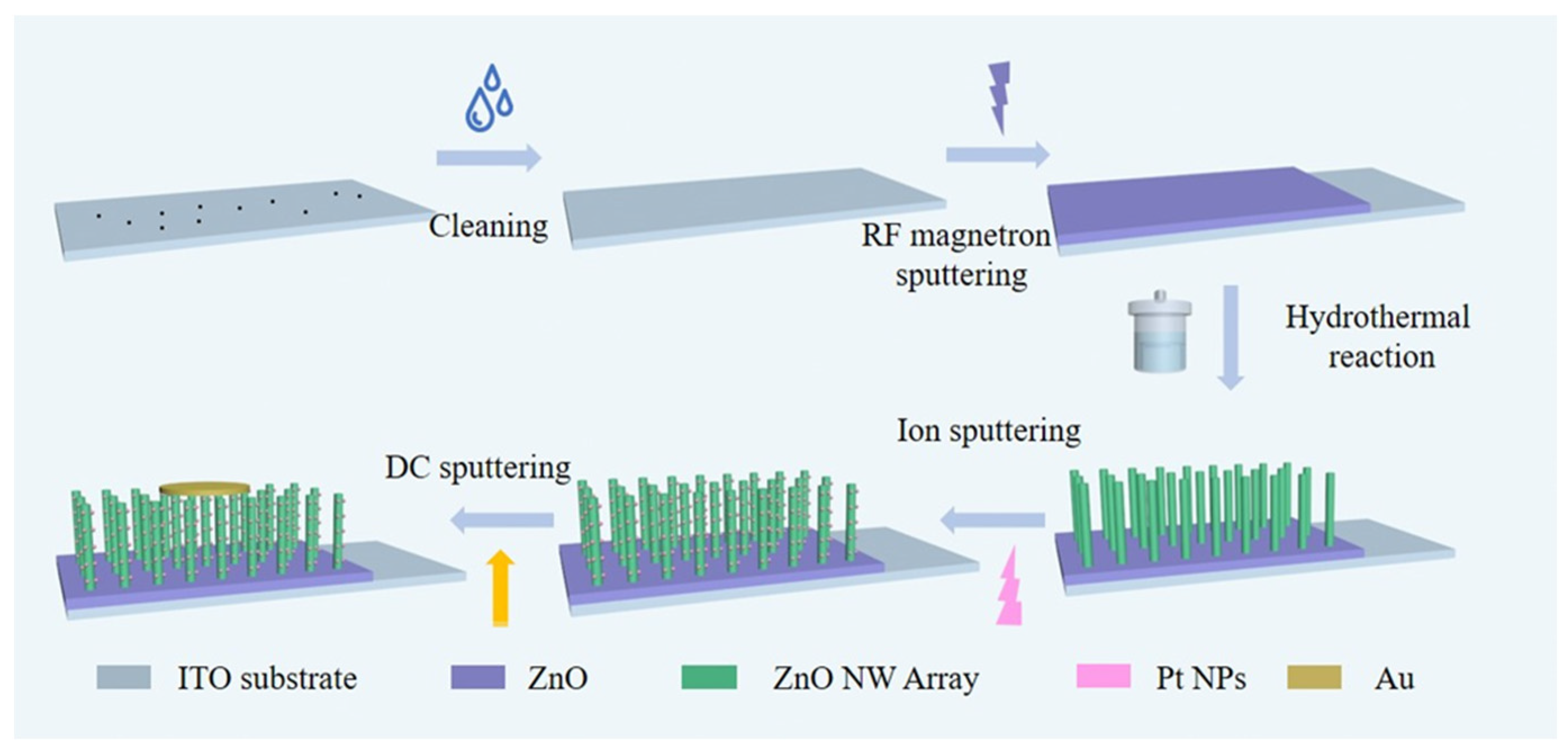
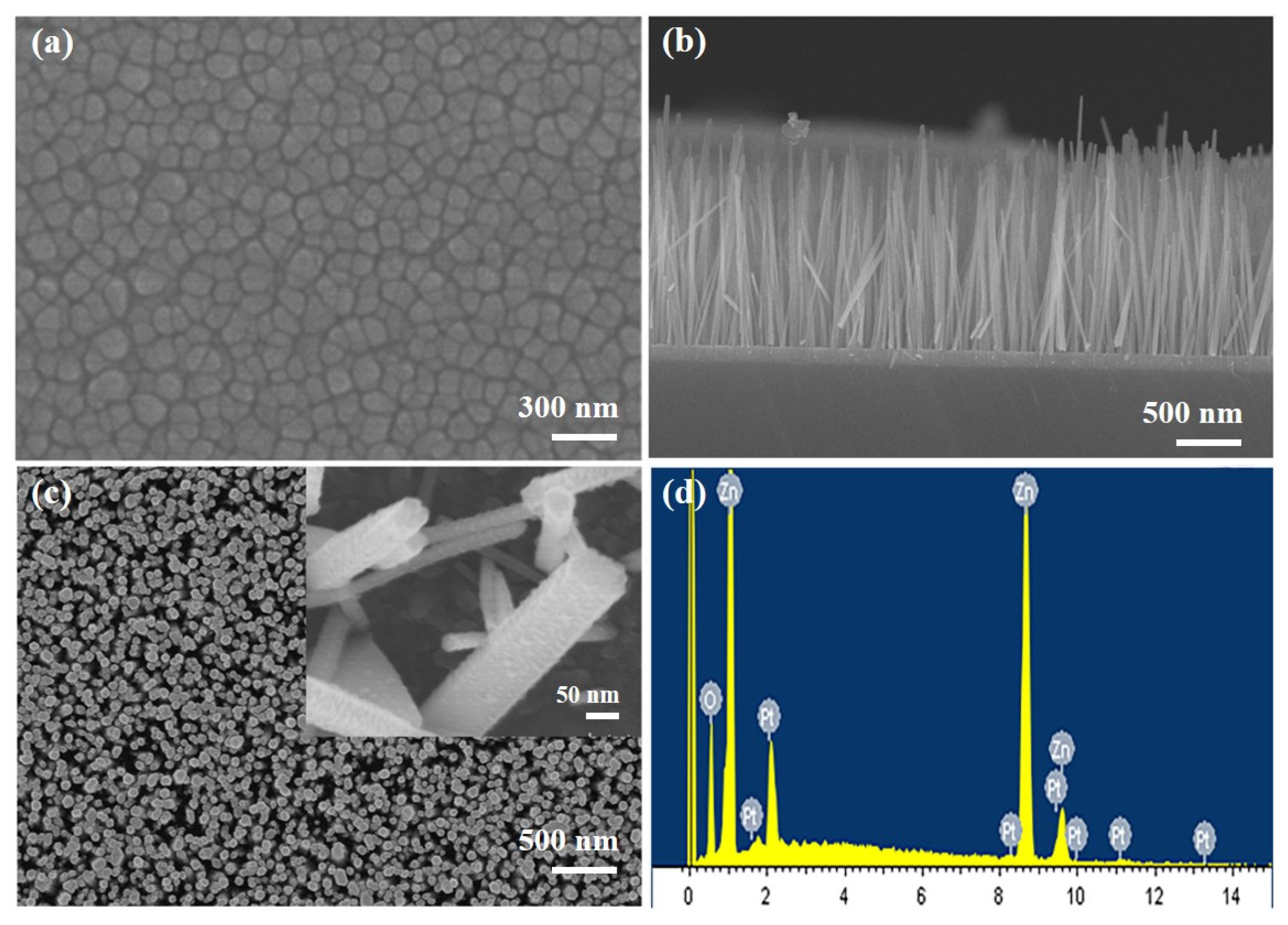
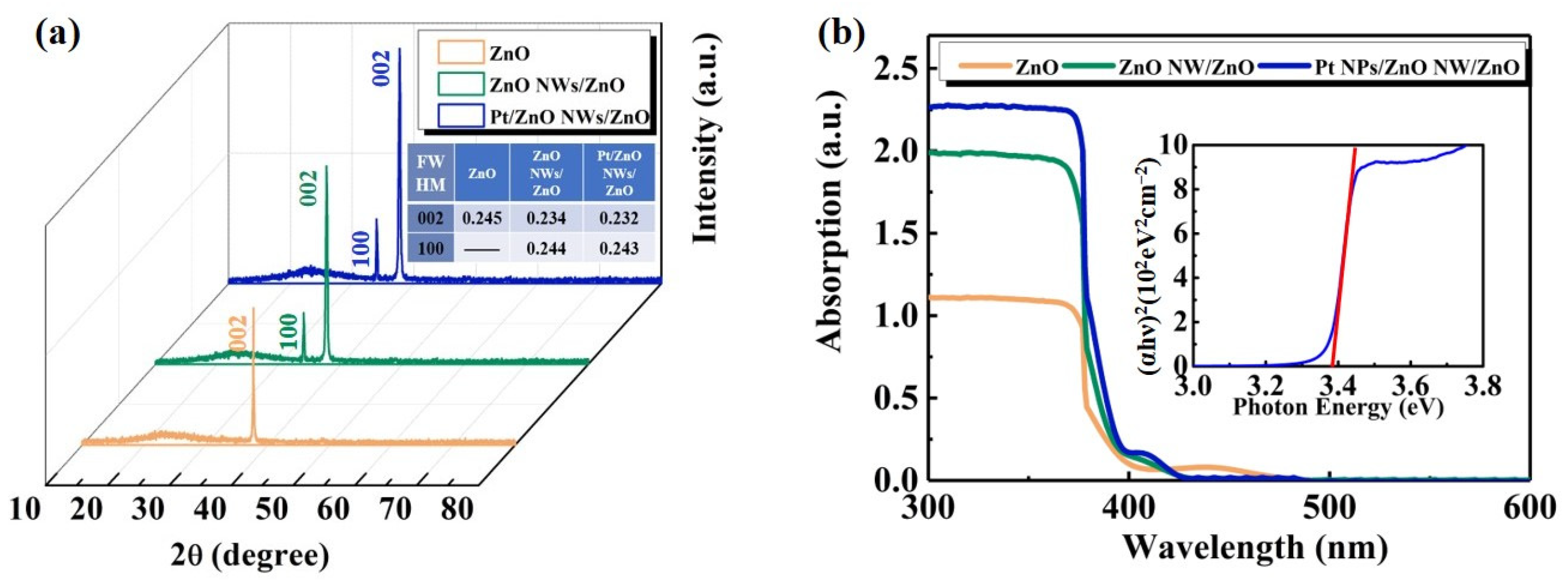
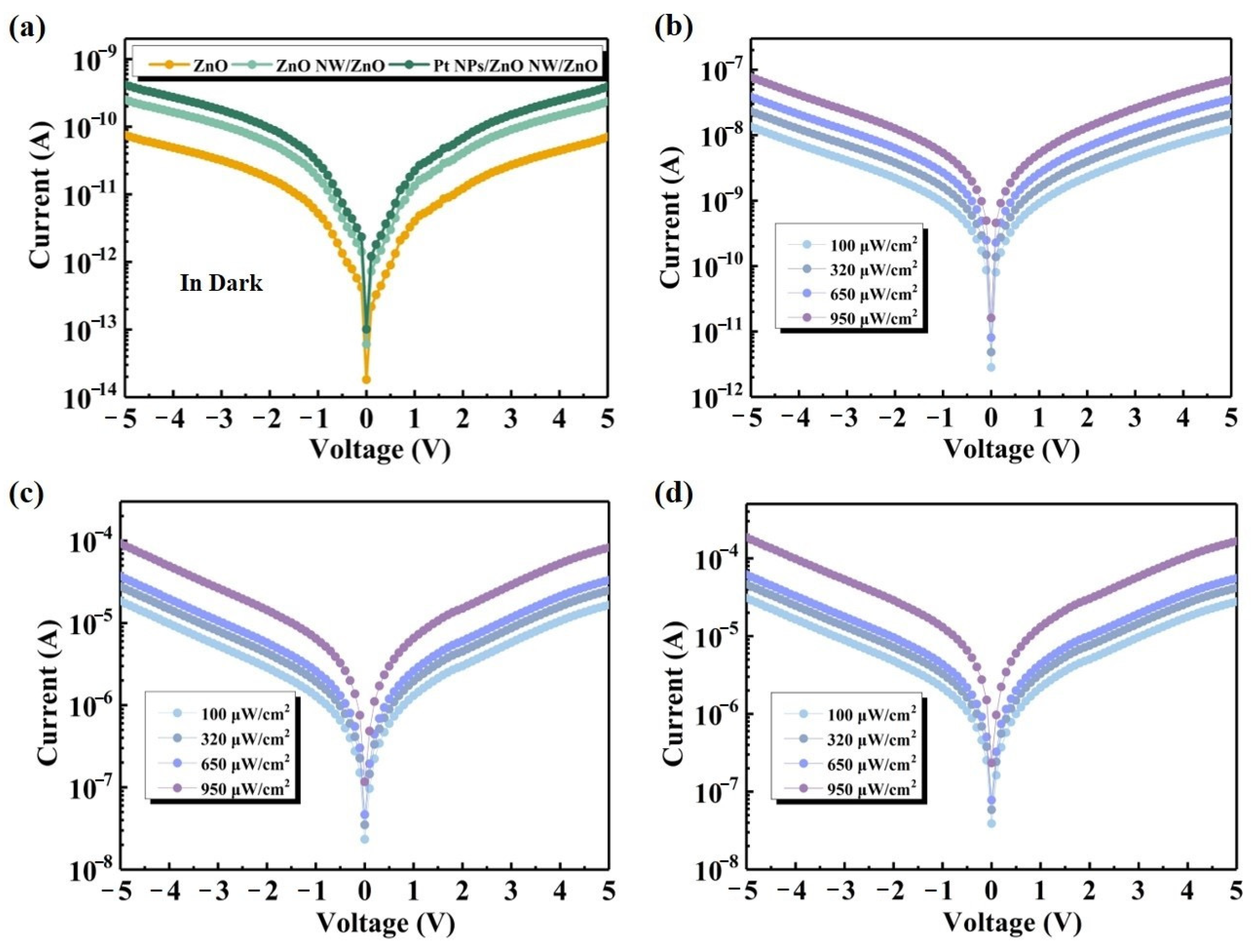

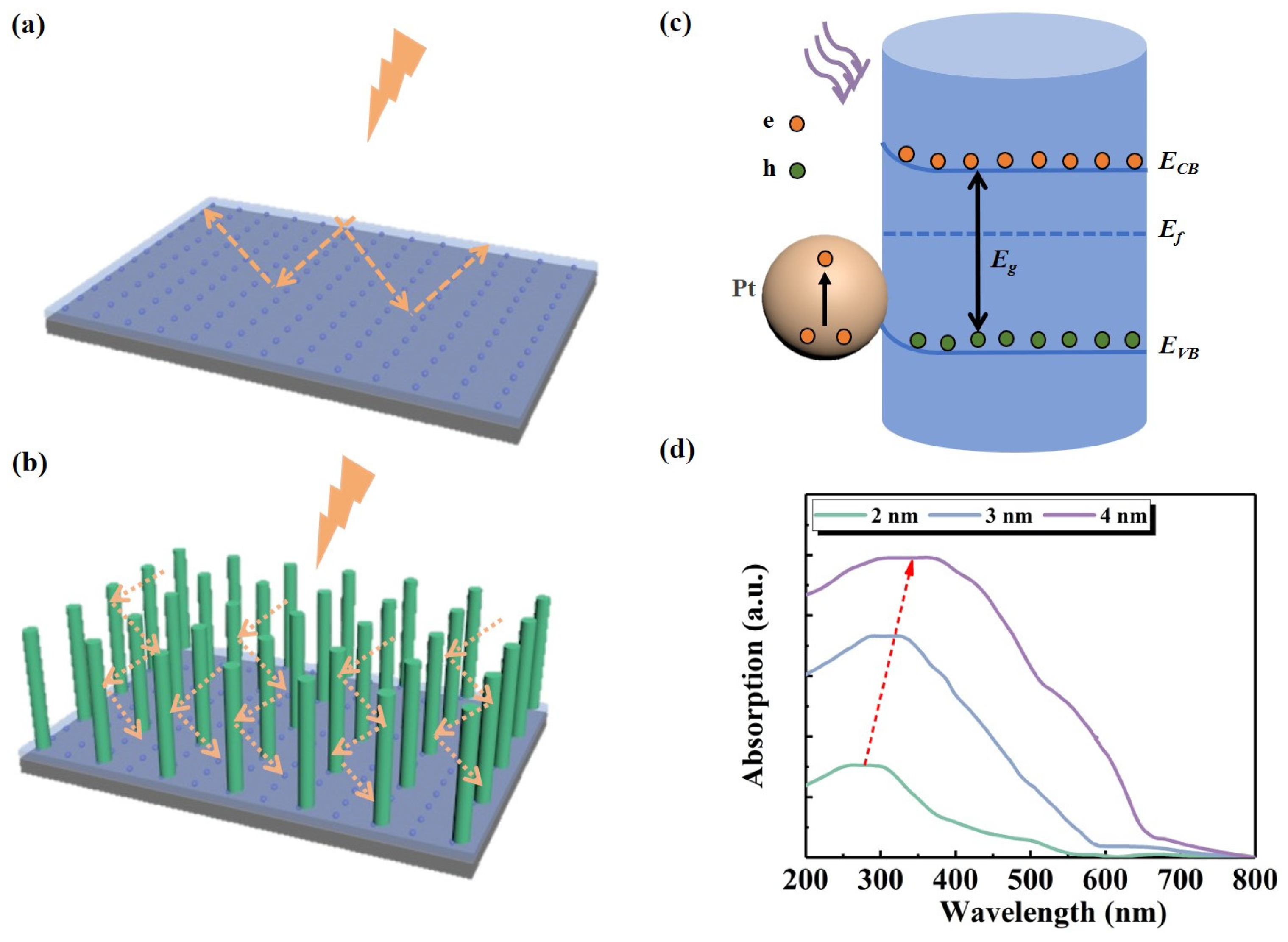

Disclaimer/Publisher’s Note: The statements, opinions and data contained in all publications are solely those of the individual author(s) and contributor(s) and not of MDPI and/or the editor(s). MDPI and/or the editor(s) disclaim responsibility for any injury to people or property resulting from any ideas, methods, instructions or products referred to in the content. |
© 2024 by the authors. Licensee MDPI, Basel, Switzerland. This article is an open access article distributed under the terms and conditions of the Creative Commons Attribution (CC BY) license (https://creativecommons.org/licenses/by/4.0/).
Share and Cite
Wang, N.; Li, J.; Wang, C.; Zhang, X.; Ding, S.; Guo, Z.; Duan, Y.; Jiang, D. Improved UV Photoresponse Performance of ZnO Nanowire Array Photodetector via Effective Pt Nanoparticle Coupling. Nanomaterials 2024, 14, 1442. https://doi.org/10.3390/nano14171442
Wang N, Li J, Wang C, Zhang X, Ding S, Guo Z, Duan Y, Jiang D. Improved UV Photoresponse Performance of ZnO Nanowire Array Photodetector via Effective Pt Nanoparticle Coupling. Nanomaterials. 2024; 14(17):1442. https://doi.org/10.3390/nano14171442
Chicago/Turabian StyleWang, Nan, Jianbo Li, Chong Wang, Xiaoqi Zhang, Song Ding, Zexuan Guo, Yuhan Duan, and Dayong Jiang. 2024. "Improved UV Photoresponse Performance of ZnO Nanowire Array Photodetector via Effective Pt Nanoparticle Coupling" Nanomaterials 14, no. 17: 1442. https://doi.org/10.3390/nano14171442





